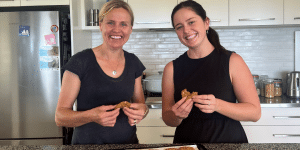Acute lower back pain – 7 things you need to know

Acute lower back pain (LBP) is a very common problem. It is estimated that between 60-80% of Australians will suffer from low back pain at some time in their lives. About 80% of acute low back pain episodes resolve in less than 4 weeks and are not due to serious back problems. However, recurrence is common. In most cases the advice is to keep as active as possible through ongoing participation in work and recreational activities.
Understanding the back
The spine or spinal column is made up of many bones called vertebrae. There are three joints between each vertebra.

- At the front of the spine there is a disc. The discs are made of strong rubber-like tissue which allows the spine to be fairly flexible and provides shock absorption. Discs CANNOT slip!
- Facet joints are formed between vertebrae on each side of the spine and help to guide lateral and rotational movement
- Strong ligaments attach to each vertebra. These give extra support and strength to the spine
- Various muscles also surround and are attached to different parts of the spine
- Muscles may act to produce movement, stabilise the spine, or both
- The spinal cord travels within and is protected by the spine. The cord terminates at T12 (the level of the lowest rib) where it separates into a number of individual nerves
- Nerves from the spinal cord exit via canals between the vertebrae to take and receive messages to and from various parts of the body
Simple ‘mechanical’ LBP
This is the most common type of back pain. Simple back pain means that the pain is not due to any underlying disease that can be found. The cause of most cases is thought to be a sprain or small tear to a ligament or muscle. This may be caused by heavy lifting, an awkward twisting movement or poor posture. Minor problems with the discs between the vertebrae or facet joints may also cause pain. Often the exact site and cause of the pain is not clear.
Simple does not mean that the pain is mild – the pain can range from mild to severe. Typically the pain is in one area of the lower back, but sometimes it spreads to the buttocks or thighs.
Symptoms typically improve from constant pain to intermittent pain to lower level discomfort and full recovery over 4-8 weeks. In a small number of cases the symptoms continue for several months or longer (chronic or persisting back pain).
Symptoms of lower back pain
Most cases of back pain that develop suddenly are due to simple back pain. Some people just ‘get on with it’ and treat it themselves – and indeed most get better quickly. However if in doubt, see your physiotherapist or doctor for a check-over and advice.
As a general guide, back pain with any of the following symptoms may indicate a more serious problem. You should tell your physiotherapist or doctor if they occur:
- Weakness of any muscles in your leg or foot
- Altered sensation such as pins and needles or numbness in parts of a buttock, leg, or foot
- Problems with your bladder or bowels such as loss of control which is not normal for you
- Weight loss, or if you feel generally unwell
- Pain that develops gradually and slowly gets worse
Do I need any tests?
Severity of pain is not reliably associated with seriousness of pathology.
Your physiotherapist or doctor will normally be able to diagnose simple back pain based on your description of symptoms and via physical examination. In most cases no tests are needed. X-rays or scans of the back are often not helpful, only showing normal signs of age-related ‘wear and tear’ that may not be related to your pain and will not change your treatment plan. Scans may be indicated in cases of persisting pain, or if symptoms such as those listed above are present.
Treatment of lower back pain
Keep active: This may not be possible at first if pain is severe and it may be necessary to modify your usual home, work or leisure activities. However, get back into normal activities as soon as you are able. As a rule, don’t do anything which causes a lot of pain, but mild discomfort is OK when you are trying to keep active. Studies have shown that the people who recover best from simple back pain are those who modify activity and stay at work.
Avoid prolonged sitting: Most cases of simple back pain are made worse by sitting down. Try not to sit for longer than 20 minutes at a time. Get up and stretch, keep moving or go for a walk. If you do have to sit, make sure that you have the right support. A lumbar roll or a rolled towel to support the normal curve in your lumbar spine may help.
Medication: If you need pain relief, simple over the counter analgesics such as paracetamol are recommended. Rather than ‘now and again’ it is best to take medication regularly as it may prevent the pain from getting severe, and enable you to keep active.
Do not rest in bed for long periods: In the past, advice had been to rest until the pain eases. It is now known that you are more likely to develop chronic (persistent) back pain if you rest a lot rather than keep active.
Physiotherapy can help!
Your physiotherapist can help using the following:
- Advice and encouragement of activity
- Mobilisation and manipulation
- Taping, bracing and postural supports
- Specific stabilization exercises
- General exercise and stretches
- Posture and ergonomic advice
Preventing simple lower back pain
The following may help to prevent back pain from occurring:
Exercise: Improve the control of muscles that stabilize your trunk with a variety of activities, maintain flexibility and a healthy body weight.
Posture: Avoid stooped standing, slumped sitting or sitting for longer than 90mins without a break in any chair.
Lifting: Do not bend your back when you lift. Rather, bend from your hips and knees and lift with your leg muscles. Do not lift and twist through your back.
Sleeping: A medium to firm mattress is best.
If you are struggling with lower back pain, contact us here or book an online appointment






